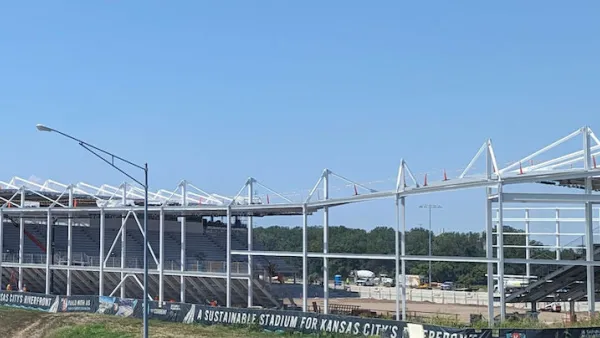HBO's John Oliver wants cities to do one thing when professional sports teams come asking for public money to build new stadiums: "Make them pay!"

"Most stadiums these days look like they were designed by a coked-up Willy Wonka," says John Oliver near the beginning of a recent segment that absolutely obliterates the recent history of professional teams taking pretty much whatever they want from cities to get the facilities they want. But Oliver's concern isn't the excess on display at these stadiums—it's the tremendous paid by taxpayers to build these new facilities.
Between 2000 and 2010, $12 billion went toward new facilities for professional teams, explains Oliver. In fact, since the 1990s, professional sports teams have a replacement rate of 90 percent. "Which begs the question," says Oliver: "Why?" Oliver can't find an answer to that question, citing a study that finds no evidence that stadium investments increase "jobs, incomes, or tax revenues."
Despite that lack of return on investment, almost every team gets something, according to Oliver. The New York Yankees, for instance, paid for their own new stadium—but it was built on land given rent and property tax free, costing the city hundreds of millions in lost revenue. May teams benefit from tax-free municipal bonds, which, as Oliver explains them, are usually spent on things like roads and schools. Among a slew of cities mentioned in the post for embarrassing capitulations to professional sports teams, Cincinnati stands out. Still paying back debts for stadiums built for the Bengals and Reds teams, Oliver notes that the taxpayers of the city are obligated to buy the Bengals a holographic instant replay machine—if and when such a device is ever invented.
Such are the lengths cities and their citizens are willing to go to for professional sports. But Oliver has a different idea: "We have to come to our senses, and stop signing these deals."
FULL STORY: John Oliver: It’s time to stop taxpayer-funded stadiums

National Parks Layoffs Will Cause Communities to Lose Billions
Thousands of essential park workers were laid off this week, just before the busy spring break season.

Retro-silient?: America’s First “Eco-burb,” The Woodlands Turns 50
A master-planned community north of Houston offers lessons on green infrastructure and resilient design, but falls short of its founder’s lofty affordability and walkability goals.

Delivering for America Plan Will Downgrade Mail Service in at Least 49.5 Percent of Zip Codes
Republican and Democrat lawmakers criticize the plan for its disproportionate negative impact on rural communities.

Test News Post 1
This is a summary

Test News Headline 46
Test for the image on the front page.

Balancing Bombs and Butterflies: How the National Guard Protects a Rare Species
The National Guard at Fort Indiantown Gap uses GIS technology and land management strategies to balance military training with conservation efforts, ensuring the survival of the rare eastern regal fritillary butterfly.
Urban Design for Planners 1: Software Tools
This six-course series explores essential urban design concepts using open source software and equips planners with the tools they need to participate fully in the urban design process.
Planning for Universal Design
Learn the tools for implementing Universal Design in planning regulations.
EMC Planning Group, Inc.
Planetizen
Planetizen
Mpact (formerly Rail~Volution)
Great Falls Development Authority, Inc.
HUDs Office of Policy Development and Research
NYU Wagner Graduate School of Public Service





























